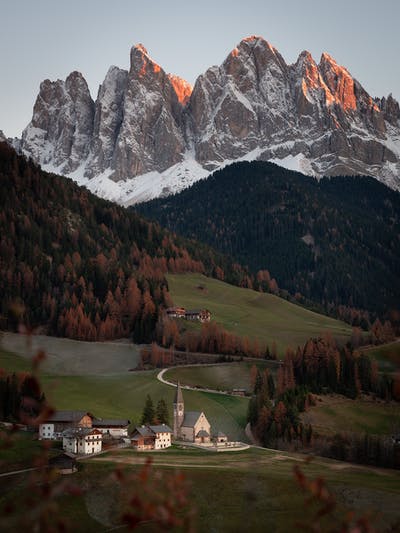Dolomites Mountains

Dolomites Mountains
The Majestic Dolomites: Nature’s Sculpture Garden
The Dolomites, a breathtaking mountain range located in northern Italy, are a true masterpiece of nature’s artistry. With their awe-inspiring peaks, jagged rock formations, and vibrant colors, the Dolomites stand as a testament to the incredible geological processes that have shaped our planet over millions of years. In this essay, we will delve deep into the Dolomites, exploring their geological origins, unique features, ecological significance, and their allure for adventure seekers and nature enthusiasts alike.
Geological Origins
The Dolomites are a part of the Southern Limestone Alps and are primarily composed of a type of rock known as dolomite, after which the range is named. Dolomite, a calcium magnesium carbonate mineral, gives the mountains their distinctive appearance and unique characteristics. The geological history of the Dolomites dates back to the Late Triassic period, approximately 230 million years ago.
During this period, the area that is now the Dolomites was submerged under a shallow sea. Over time, the remains of marine microorganisms and sediments accumulated on the sea floor, gradually forming thick layers of limestone. The transformation of this limestone into dolomite rock was a result of a complex chemical process known as dolomitization. It involves the replacement of calcium in limestone with magnesium, leading to the formation of dolomite.
The uplifting of the Earth’s crust during subsequent geological processes, such as tectonic activity, created the towering peaks and dramatic landscapes we see today. This geological history has not only shaped the physical appearance of the Dolomites but also contributed to their exceptional geological diversity.
Unique Features
The Dolomites are renowned for their distinctive features that set them apart from other mountain ranges in the world. Some of the most prominent characteristics include:
- Towering Peaks: The Dolomites boast a stunning collection of peaks that rise dramatically from the surrounding valleys. Among the most famous is the Tre Cime di Lavaredo, a trio of towering peaks that have become an iconic symbol of the region. The Marmolada, the highest peak in the Dolomites, stands at 3,343 meters (10,968 feet) above sea level, offering breathtaking vistas.
- Jagged Rock Formations: The unique jagged and spire-like rock formations of the Dolomites are a result of the dolomite rock’s inherent fragility. Erosion and weathering over millions of years have sculpted these formations into intricate and awe-inspiring shapes. The irregular peaks create an otherworldly landscape that is a paradise for climbers and photographers.
- Stunning Colors: One of the most captivating features of the Dolomites is the ever-changing colors of the rock. Depending on the time of day and the angle of sunlight, the mountains can appear in various shades of pink, orange, and red. This phenomenon, known as the “Enrosadira” or “Alpenglow,” adds to the magical allure of the Dolomites.
- Glacial Landscapes: Glaciers have played a significant role in shaping the Dolomites. U-shaped valleys, moraines, and cirques are evidence of past glacial activity. Today, these features contribute to the picturesque beauty of the region, with pristine alpine lakes nestled amidst rugged peaks.
Ecological Significance
Beyond their aesthetic beauty, the Dolomites also hold significant ecological importance. Designated as a UNESCO World Heritage Site in 2009, this unique mountain range is home to a wide variety of flora and fauna, some of which are endemic to the region.
- Biodiversity: The Dolomites support a rich biodiversity, with diverse ecosystems ranging from forests to alpine meadows. Notable wildlife species include ibex, chamois, eagles, and marmots. Rare and endemic plant species, such as the Edelweiss, thrive in the high-altitude environments of the Dolomites.
- Water Resources: The Dolomites act as a crucial water catchment area, providing freshwater to surrounding regions. The melting glaciers and snowfields contribute to the formation of rivers and streams that are essential for the local ecosystem and human communities downstream.
- Cultural Heritage: The Dolomites are not only a natural wonder but also a repository of cultural heritage. The region is inhabited by communities that have adapted to the mountain environment for centuries. Their unique traditions, architecture, and way of life are deeply intertwined with the Dolomites’ landscape.
Tourism and Recreation
The Dolomites’ natural beauty and recreational opportunities make them a magnet for tourists and adventure enthusiasts from around the world. The region offers a wide range of activities for visitors to enjoy:
- Hiking and Trekking: The Dolomites are crisscrossed with an extensive network of hiking trails, ranging from easy walks through alpine meadows to challenging multi-day treks. The Alta Via routes offer some of the most spectacular long-distance hikes in the region.
- Climbing: With its dramatic rock formations and steep walls, the Dolomites are a mecca for rock climbers. Experienced climbers come to tackle some of the most iconic routes in the world, while beginners can find suitable options for their skill level.
- Skiing and Winter Sports: During the winter months, the Dolomites transform into a winter wonderland. Ski resorts like Cortina d’Ampezzo and Alta Badia offer excellent downhill skiing, snowboarding, and cross-country skiing opportunities.
- Cycling: The Dolomites are a paradise for cyclists, with a vast network of mountain biking trails and challenging road cycling routes. The annual Maratona dles Dolomites is a renowned cycling event that attracts participants from across the globe.
- Cultural Exploration: Beyond outdoor activities, visitors can explore the charming villages and towns that dot the Dolomites. These communities offer a glimpse into the rich cultural heritage of the region, with traditional festivals, cuisine, and architecture.
Challenges and Conservation Efforts
While the Dolomites continue to enchant visitors, they also face several challenges that threaten their delicate ecosystems and unique landscapes.
- Climate Change: The impact of climate change is visible in the Dolomites, with rising temperatures leading to the retreat of glaciers and alterations in the region’s ecology. Conservation efforts are underway to mitigate the effects of climate change and protect the fragile ecosystems.
- Tourism Pressure: The popularity of the Dolomites as a tourist destination has led to increased visitor numbers during peak seasons. Sustainable tourism practices and careful management are necessary to preserve the region’s natural beauty.
- Infrastructure Development: The construction of infrastructure, such as roads and ski resorts, can have a significant impact on the environment. Balancing the needs of tourism with conservation is a continuous challenge.
- Cultural Preservation: As traditional ways of life in the Dolomites evolve, there is a need to preserve the cultural heritage of the region while allowing for economic development and modernization.
Conservation organizations, local governments, and communities in the Dolomites are working together to address these challenges and ensure the long-term protection of this remarkable mountain range. Efforts include sustainable tourism initiatives, habitat restoration projects, and education programs to raise awareness about the importance of preserving the Dolomites’ unique environment and culture.
The Dolomites, with their stunning geological origins, unique features, ecological significance, and recreational opportunities, are a true wonder of the natural world. These mountains inspire awe and reverence in all who visit, and they remind us of the incredible beauty and diversity of our planet. As we continue to explore and appreciate the Dolomites, it is essential that we also take on the responsibility of preserving this natural masterpiece for future generations to enjoy and cherish. The Dolomites are not just a destination; they are a testament to the enduring power and artistry of nature.




